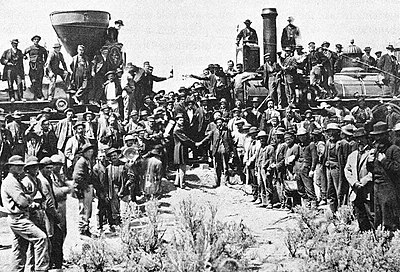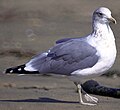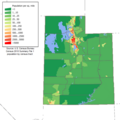Portal:Utah
The Utah Portal  Utah (/ˈjuːtɑː/ YOO-tah, /ˈjuːtɔː/ ⓘ YOO-taw) is a state in the western United States. It is one of the Mountain States, sharing the Four Corners region with Arizona, Colorado, and New Mexico. It also borders Wyoming to the northeast, Idaho to the north, and Nevada to the west. In comparison to all the U.S. states and territories, Utah, with a population of just over three million, is the 13th largest by area, the 30th most populous, and the 11th least densely populated. Urban development is mostly concentrated in two regions: the Wasatch Front in the north-central part of the state, which includes the state capital, Salt Lake City, and is home to roughly two-thirds of the population; and Washington County in the southwest, which has approximately 180,000 residents. Most of the western half of Utah lies in the Great Basin. Utah has been inhabited for thousands of years by various indigenous groups, such as the ancient Puebloans, the Navajo, and the Ute. The first Europeans to arrive – in the mid-16th century – were the Spanish. Because of the region's challenging geography and harsh climate, it only became a peripheral part of New Spain (and later of Mexico). Even while it was Mexican territory, many of the Utah region’s earliest European settlers were from the United States; notable among these were Mormons who were fleeing marginalization and persecution in the United States and arrived via the so-called Mormon Trail. In 1848, after the Mexican–American War, the region was annexed by the U.S., becoming part of the Utah Territory, which included what later became Colorado and Nevada. Disputes between the dominant Mormon community and the federal government delayed Utah's admission as a state: in 1896, after it agreed to outlaw polygamy, it was admitted as the 45th state. People from Utah are known as Utahns. Slightly over half of all Utahns are Mormons, the vast majority of whom are members of the Church of Jesus Christ of Latter-day Saints (LDS Church), which has its world headquarters in Salt Lake City; Utah is the only state where a majority of the population belongs to a single church. The LDS Church greatly influences Utahn culture, politics, and daily life, though since the 1990s the state has become more religiously diverse as well as secular. (Full article...) Entries here consist of Good and Featured articles, which meet a core set of high editorial standards.
Ralph Vary Chamberlin (January 3, 1879 – October 31, 1967) was an American biologist, ethnographer, and historian from Salt Lake City, Utah. He was a faculty member of the University of Utah for over 25 years, where he helped establish the School of Medicine and served as its first dean, and later became head of the zoology department. He also taught at Brigham Young University and the University of Pennsylvania, and worked for over a decade at the Museum of Comparative Zoology at Harvard University, where he described species from around the world. Chamberlin was a prolific taxonomist who named over 4,000 new animal species in over 400 scientific publications. He specialized in arachnids (spiders, scorpions, and relatives) and myriapods (centipedes, millipedes, and relatives), ranking among the most prolific arachnologists and myriapodologists in history. He described over 1,400 species of spiders, 1,000 species of millipedes, and the majority of North American centipedes, although the quantity of his output was not always matched with quality, leaving a mixed legacy to his successors. He also did pioneering ethnobiological studies with the Goshute and other indigenous people of the Great Basin, cataloging indigenous names and cultural uses of plants and animals. Chamberlin was celebrated by his colleagues at the University of Utah, however he was disliked among some arachnologists, including some of his former students. After retirement he continued to write, publishing on the history of education in his home state, especially that of the University of Utah. (Full article...) Selected image - 227 (plate number) East and West Shaking Hands at Laying Last Rail. Andrew J. Russell photo after the Golden Spike ceremony.
February selected anniversaries
Selected biography -Loretta Young (born Gretchen Michaela Young; January 6, 1913 – August 12, 2000) was an American actress. Starting as a child, she had a long and varied career in film from 1917 to 1989. She received numerous honors including an Academy Award, two Golden Globe Awards, and three Primetime Emmy Awards as well as two stars on the Hollywood Walk of Fame for her work in film and television. She won the Academy Award for Best Actress for her role in the film The Farmer's Daughter (1947), and received her second Academy Award nomination for her role in Come to the Stable (1949). She also starred in films such as Born to Be Bad (1934), Call of the Wild (1935), The Crusades (1935), Eternally Yours (1939), The Stranger (1946), The Bishop's Wife (1947), and Key to the City (1950). (Full article...) Selected article -The 2002 Winter Olympics, officially the XIX Olympic Winter Games and commonly known as Salt Lake 2002 (Arapaho: Niico'ooowu' 2002; Gosiute Shoshoni: Tit'-so-pi 2002; Navajo: Sooléí 2002; Shoshoni: Soónkahni 2002), were an international winter multi-sport event that was held from February 8 to 24, 2002, in and around Salt Lake City, Utah, United States. Salt Lake City was selected as the host city in June 1995 at the 104th IOC Session. They were the eighth Olympics to be hosted by the United States, and the most recent to be held in the country until 2028, when Los Angeles will host the 34th Summer Olympics. The 2002 Winter Olympics and Paralympics were both organized by the Salt Lake Organizing Committee (SLOC), the first time that both events were organized by a single committee, and inspiring other Olympic and Paralympic Games to be organized by such since then. (Full article...) Did you know -
Selected panorama - Tower of Babel in Arches National Park
TopicsCategoriesGeneral imagesThe following are images from various Utah-related articles on Wikipedia.
State facts
State symbols:
Featured contentArticles:
Lists:
Pictures: Related portals
Lists
Related WikiProjectsNew articlesThis list was generated from these rules. Questions and feedback are always welcome! The search is being run daily with the most recent ~14 days of results. Note: Some articles may not be relevant to this project.
Rules | Match log | Results page (for watching) | Last updated: 2025-01-31 23:06 (UTC) Note: The list display can now be customized by each user. See List display personalization for details.
Things you can doAssociated WikimediaThe following Wikimedia Foundation sister projects provide more on this subject:
Discover Wikipedia using portals |


















































































